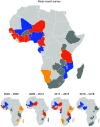Spatio-temporal trends in anaemia among pregnant women, adolescents and preschool children in sub-Saharan Africa
- PMID: 33190664
- PMCID: PMC10195357
- DOI: 10.1017/S1368980020004620
Spatio-temporal trends in anaemia among pregnant women, adolescents and preschool children in sub-Saharan Africa
Abstract
Objective: We investigated the spatiotemporal trends in the burden of maternal, adolescent and child anaemia in sub-Saharan Africa (SSA) and evaluated some individual and household predictors of anaemia.
Design: Average Hb concentrations and anaemia prevalence were estimated, plotted over time and mapped by country and sub-region. Multilevel linear regression models were used to evaluate individual and household predictors of Hb concentration.
Participants: Data from Demographic and Health Surveys (DHS) spanning 2000-2018 were merged into data sets for 37 623 pregnant women, 89 815 older adolescent girls and 401 438 preschool children.
Setting: The merged DHS represent nationally representative samples from thirty-three countries.
Results: Prevalence of anaemia remains high in SSA, affecting 60, 36 and 44 % of children, adolescents and pregnant women, respectively. Anaemia prevalence among children did not materially improve from 2000 to 2018. Anaemia prevalence among older adolescent girls and pregnant women did not also improve, but this masks a period of improvement followed by depreciation in population anaemia status. Pregnant adolescents had 12·5 g/l (95 % CI: 11·3, 13·6) lower Hb concentration compared with non-pregnant adolescents and 1·7 g/l (95 % CI: 0·7, 2·6) lower Hb concentration compared with pregnant women > 40 years, respectively. Stunting and wasting were associated with 1·3-3·3 g/l lower Hb concentration among children. Other significant predictors of Hb concentration were educational attainment, wealth quintiles, source of drinking water, number of children < 5 years in the household and possession of bed-nets.
Conclusion: Anaemia in SSA has not improved remarkably since year 2000 and remains excessive among children.
Keywords: Adolescent girls; Africa; Anaemia; Children; Pregnant women.
Figures



 , 31–40;
, 31–40;  , 41–50;
, 41–50;  , 51–60;
, 51–60;  , 61–70;
, 61–70;  , 71–80;
, 71–80;  , 81 and above
, 81 and above

 , 21–30;
, 21–30;  , 31–40;
, 31–40;  , 41–50;
, 41–50;  , 51–60;
, 51–60;  , 61–70;
, 61–70;  , 71 and above
, 71 and above

 , 5–10;
, 5–10;  , 11–20;
, 11–20;  , 21–30;
, 21–30;  , 31–40
, 31–40References
-
- Balarajan Y, Ramakrishnan U, Özaltin E et al. (2011) Anaemia in low-income and middle-income countries. Lancet 378, 2123–2135. - PubMed
MeSH terms
LinkOut - more resources
Full Text Sources
Medical
Research Materials

